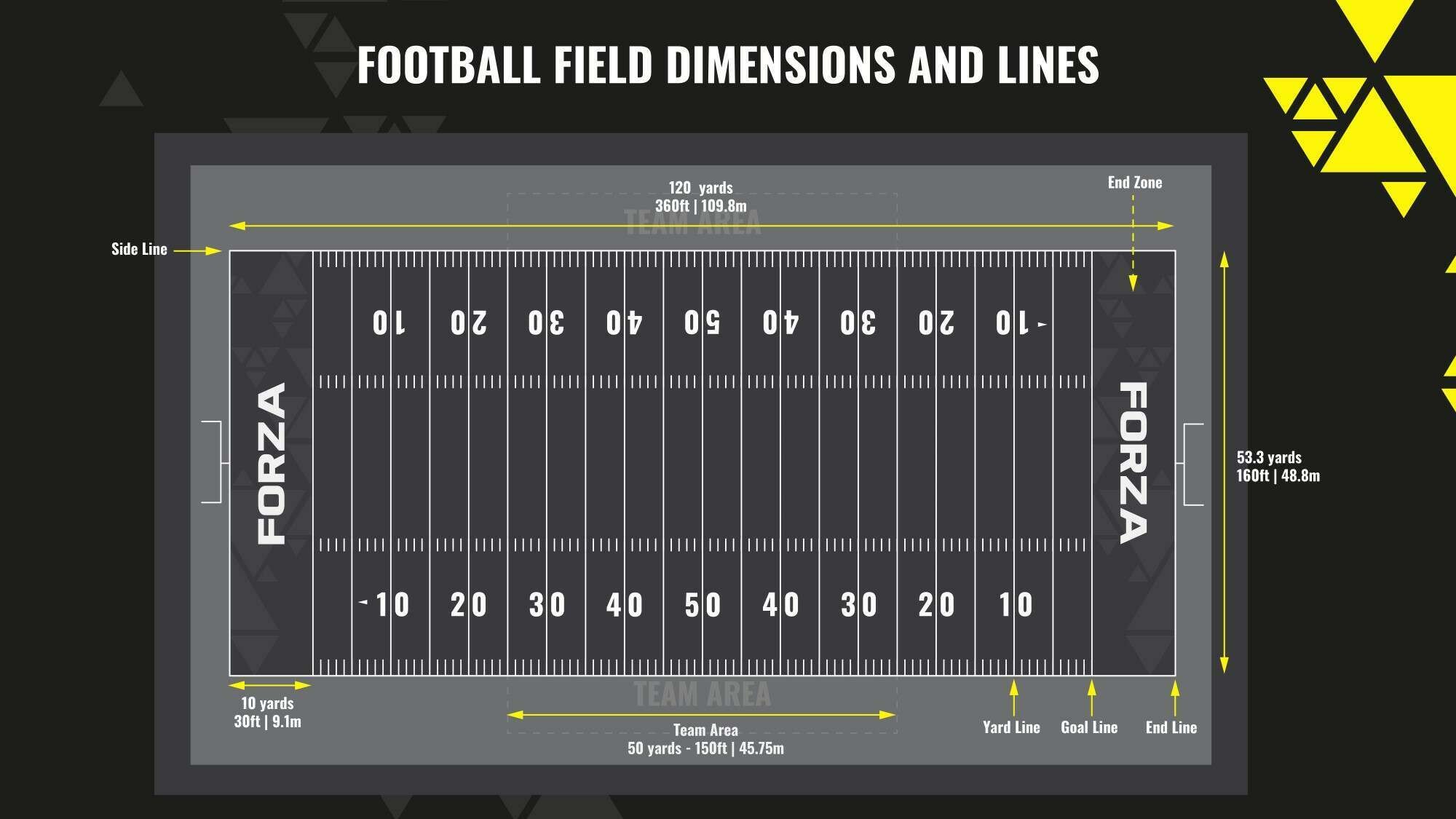Football, a sport synonymous with thrilling plays and strategic maneuvers, unfolds on a meticulously measured battlefield – the football field. Whether you’re a facility manager prepping for the season, a coach strategizing plays, a player honing your skills, or simply a fan deepening your game knowledge, understanding the dimensions of a football field is fundamental. This guide provides a comprehensive overview of football field dimensions, markings, and key areas, ensuring you grasp every yard of the gridiron.
Breaking Down the Football Field Length
When asking “How Long Is A Football Field?”, you’re actually looking at a total length of 120 yards (360 feet or 109.8 meters). However, the action primarily happens across a 100-yard (300 feet or 91.4 meters) stretch, measured between the goal lines. Beyond each goal line lies a 10-yard (30 feet or 9.1 meters) end zone. These end zones are crucial for scoring touchdowns. This standard 120-yard length applies uniformly across NFL, NCAA (college), and high school football fields, ensuring consistent play across these levels.
Variations in football field length primarily occur in youth football leagues. To accommodate younger players, the distance between goal lines is often reduced, typically ranging from 50 to 80 yards (150-240 feet or 45.7-73.2 meters). Notably, in NFL FLAG, a popular format for younger athletes, the field is 70 yards (210 feet or 64 meters) long, including the standard 10-yard end zones at each end.
Football Field Width: Consistent Across the Levels
The width of a football field is a constant 53.3 yards (160 feet or 48.8 meters) from high school through to the NFL. This standardized width means that the playing area remains consistent regardless of whether it’s a high school game under the Friday night lights, a college rivalry showdown, or a professional Sunday spectacle. This consistent width ensures players at all levels are accustomed to the same lateral playing space.
Similar to length, variations in width are mainly found in youth leagues. For example, NFL FLAG fields are 30 yards wide (90 feet or 27.4 meters). Other junior leagues might have fields varying in width from 23 to 50 yards (69-150 feet or 21-45.7 meters), tailored to the age and skill level of the players.
Acreage of a Football Field
A regulation-size football field encompasses approximately 1.32 acres, which translates to 57,600 square feet. This calculation is based on the standard dimensions of 120 yards (360 feet or 109.8 meters) in length and 53.3 yards (160 feet or 48.8 meters) in width. Understanding the acreage provides context for facility management and space planning when considering football field construction or maintenance.
Decoding Football Field Markings and Areas
Beyond just length and width, a football field is a canvas of lines and markings, each serving a crucial purpose in gameplay. These markings are not arbitrary; they are essential for officiating, player positioning, and understanding game progression.
Sidelines
Sidelines are the boundary lines running the entire length of the field (120 yards or 360 feet or 109.8 meters). They define the outer edges of the playing area. If a player carrying the ball steps outside a sideline, they are ruled out of bounds, halting the play. The ball is then placed back in bounds at the nearest yard line from where the player exited, ready for the next down. Team benches and designated team areas are also located just beyond the sidelines.
End Zones
End zones are the 10-yard territories located at both ends of the field, between the goal line and the end line, spanning the full width of the field. These are the areas players strive to reach to score a touchdown. Consistent in size across high school, college, and NFL, end zones measure 10 yards (30 feet or 9.1 meters) deep and 53.3 yards (160 feet or 48.8 meters) wide. In NFL FLAG, the 10-yard end zone dimension is also maintained.
Yard Lines
Yard lines are solid white lines that run across the width of the field every 5 yards (15 feet or 4.6 meters), starting from each goal line. Every tenth yard (30 feet or 9.1 meters) is further emphasized with field numbers placed on both sides of the field near the sidelines. These numbers ascend in increments of ten from the goal line towards the 50-yard line at the field’s center. They are crucial for tracking the ball’s position and the yards needed for a first down.
Hash Marks
Hash marks are short, white lines marking each individual yard (3 feet or 0.9 meters) between the goal lines. They are 2 feet (61 cm) in length. If a play concludes outside the hash marks or near the sideline, the subsequent play begins at the nearest hash mark. There are sets of hash marks near each sideline and additional sets closer to the center of the field.
The distance between the inner sets of hash marks varies depending on the level of play.
- High School: Central hash marks are 17.6 yards (53 feet or 16.2 meters) apart, with each set 26.5 feet (8.1 meters) from the field’s center.
- College: The distance narrows, with central hash marks 13.3 yards (40 feet or 12.2 meters) apart and each set 6.6 yards (20 feet or 6.1 meters) from the middle.
- NFL: The gap is further reduced to 6 yards (18 feet or 5.5 meters) between central hash marks, each set just 3 yards (9 feet or 2.7 meters) from the center.
These hash mark variations influence field spacing and play strategy at different levels of football.
Football Field Goal Post Dimensions: Height and Width
Field goal posts stand at the center of each end line, in the middle of the end zone. The crossbar height is consistently 10 feet (3 meters) above the ground for high school, college, and NFL football. However, the overall height and width of the goal posts differ between high school and higher levels.
For college and NFL goal posts:
- Side posts extend 25 feet (7.6 meters) above the crossbar, making the total height 35 feet (10.7 meters).
- The width between the vertical posts is 18 feet 6 inches (5.6 meters).
High school football goal posts are typically shorter and wider:
- Side post height is generally between 12-15 feet (3.7-4.6 meters), resulting in an overall height of 22-25 feet (6.7-7.6 meters).
- The width between posts is wider at 23 feet 4 inches (7.1 meters).
These dimensional differences impact field goal kicking accuracy and strategy across different levels.
How to Mark a Football Field: A Step-by-Step Guide
Marking a football field accurately is crucial and requires precision. While the time taken varies with crew size, a team of three can typically mark a field in 6-7 hours.
Here’s a general process:
-
Line Width: Standard line width is 4 inches (10 cm), though sidelines and end lines can be wider. Hash marks are 2 feet (61 cm) long. Lines are usually white, but goal lines and team zones can be in contrasting colors.
-
Tools: Essential tools include a long tape measure and a line marking machine (electric line marking trikes are recommended for accuracy and longevity).
-
Yard Line Numbers: Position yard-line numbers 9 yards (27 feet or 8.23 meters) from the sidelines and 1 foot (0.3 meters) from the full yard lines marking every 10 yards.
-
Marking Process:
- Start by marking one sideline, indicating positions for goal lines and full-field yard lines along it.
- Establish the 50-yard line and center-field mark to find the field’s midpoint.
- Mark end lines, including indicators for central hash marks and the goal post center.
- Connect end lines and the 50-yard line to the opposite sideline.
- Finally, mark remaining full-yard lines and all sets of hash marks.
Accurate marking ensures fair play and adherence to regulations throughout the football season.
Football Field vs. Soccer Field: Key Differences
While sometimes confusingly sharing similar names in some regions, soccer (football outside the US) and American football fields differ significantly due to the distinct rules and gameplay of each sport.
| Soccer Field Vs Football Field Dimensions | “`


